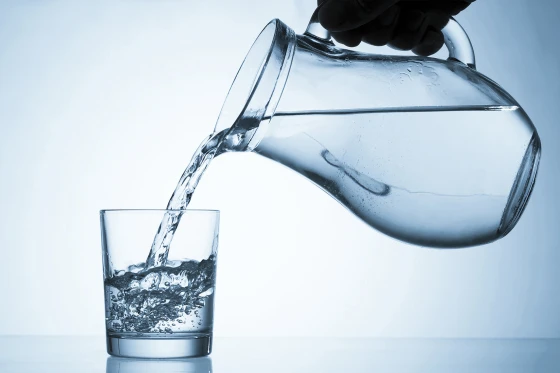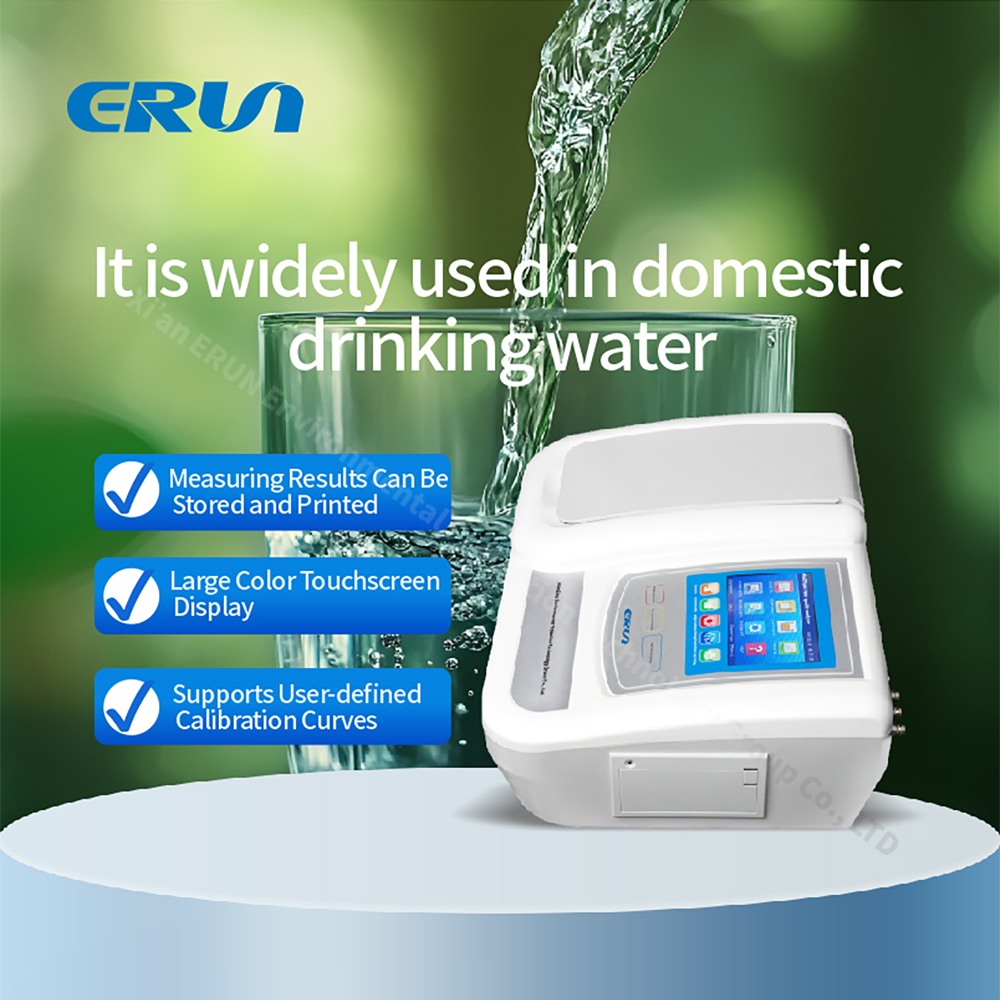Turbidity is one of the most important indicators of drinking water quality. High turbidity not only affects appearance and taste but also reduces disinfection efficiency and increases the risk of microbial contamination. Ensuring low turbidity is essential for bottled drinking water manufacturers, water treatment plants, and municipal suppliers who must deliver clean, safe, and visually appealing water to consumers.
This article explains how to reduce drinking water turbidity, the causes of turbidity spikes, the most effective treatment technologies, and how advanced tools such as the ERUN-ST7 Water Multi-Parameter Water Quality Analyzer can support high-precision water quality monitoring throughout the process.
Turbidity describes the cloudiness or haziness of water caused by suspended particles such as clay, silt, organic matter, microorganisms, and other fine materials. It is commonly measured in NTU (Nephelometric Turbidity Units), reflecting how much light particles scatter in water.
High turbidity is not merely an aesthetic issue. Cloudy water can:
Interfere with chlorination and UV disinfection
Protect bacteria from being killed
Indicate contamination from runoff or compromised infrastructure
Trigger unpleasant taste, odor, and appearance
Regulatory bodies such as the WHO and EPA impose strict turbidity standards to ensure public health. Maintaining low turbidity is therefore essential for producing safe drinking water, particularly in industries such as bottled water production, where consumers demand clarity and purity.
Accurate turbidity measurement is the foundation of effective treatment and quality management.
Turbidity is typically assessed using:
Nephelometric sensors
Turbidity meters
Laboratory turbidimeters
These instruments measure light scatter to determine particle concentration. However, turbidity alone cannot always reveal the root causes of contamination. Operators must also evaluate related indicators to fully understand water quality.
The ERUN-ST7 Water Multi-Parameter Water Quality Analyzer is designed specifically for the bottled drinking water industry, integrating advanced sensing technology and intelligent analysis algorithms.
ERUN-ST7 offers rapid, accurate multi-parameter measurement of key drinking water indicators, including:
pH
Conductivity
TDS
Water temperature
Dissolved oxygen
Additional critical quality parameters
Its high-precision design allows bottled water manufacturers and laboratories to detect subtle changes that may indicate turbidity issues, filtration failures, or contamination risks. Real-time monitoring provides data support for treatment decisions and ensures continuous product quality and compliance.

Understanding the source of turbidity helps identify the correct treatment solution.
Soil erosion and sediment runoff
Seasonal rainfall increases suspended solids
Algae or organic matter entering surface water sources
Pipe corrosion releases metal oxides
Disturbed sediment in old distribution networks
Biofilm detachment
Wastewater discharge
Industrial runoff containing fine particles
Malfunctioning filtration or pretreatment systems
Each cause may require a different approach, emphasizing the need for comprehensive monitoring tools like ERUN-ST7.
This section addresses the primary question: how to reduce the turbidity of drinking water effectively.
This is one of the most widely used turbidity treatment processes. Coagulants such as alum, ferric chloride, and polyaluminum chloride neutralize particle charges. Flocculants then help these particles clump together into larger flocs, which settle or filter out more easily.
Coagulation and flocculation are essential in both municipal systems and commercial bottled water plants.
After coagulation, water enters sedimentation tanks where flocs settle by gravity. This step significantly reduces turbidity before filtration. Clarifiers and lamella plates improve efficiency for high-volume systems.
Filtration is the core turbidity removal technology and includes:
Rapid sand filtration
Activated carbon filtration
Cartridge filters
Ultrafiltration (UF)
Microfiltration (MF)
Membrane systems for bottled drinking water
Membrane filtration, in particular, offers high precision and consistency for premium bottled water production.
Although disinfection does not reduce turbidity directly, lower turbidity significantly improves disinfection performance. UV, ozone, and chlorine are more effective when the water is clear.
For households or emergency use, turbidity can be reduced by:
Boiling
Cloth or paper filtration
Portable carbon filters
Gravity-fed purification devices
These methods are temporary and less effective for commercial needs.
Monitoring is essential to verify whether treatment systems are working correctly.
ERUN-ST7 provides comprehensive real-time detection of parameters associated with turbidity issues, enabling operators to:
Validate coagulation and filtration performance
Detect fluctuations in conductivity or TDS that indicate contamination
Identify early warning signs of turbidity spikes
Bottled water manufacturers require strict compliance with quality standards. ERUN-ST7 ensures consistent water quality by offering:
High-precision measurement accuracy
Intelligent analysis algorithms
Rapid data capture for quality control records
Its flexibility makes the ERUN-ST7 suitable for use at:
Water bottling plants
Inspection laboratories
Source water sampling locations
Quality control checkpoints

Protect source water from runoff and contamination.
Maintain filtration systems through regular backwashing and replacement.
Use continuous monitoring tools such as ERUN-ST7 to detect changes early.
Maintain distribution pipes to prevent corrosion and sediment release.
Keep detailed quality logs for trend analysis and compliance.
Turbidity is a critical indicator of drinking water safety. Reducing turbidity requires a combination of coagulation, sedimentation, filtration, and effective monitoring. With rising consumer expectations for clarity and purity, bottled water manufacturers must adopt advanced tools to ensure consistent quality.
The ERUN-ST7 Water Multi-Parameter Water Quality Analyzer delivers high-precision, rapid, and intelligent detection of key drinking water parameters, making it an essential instrument for turbidity reduction, quality control, and safety assurance.
For more information about advanced water testing instruments, visit erunwas.com.
References
U.S. Environmental Protection Agency (EPA). Turbidity: Drinking Water Parameter Quick Reference Guide.
https://www.epa.gov/system/files/documents/2021-07/parameter-factsheet_turbidity.pdf
World Health Organization (WHO). Guidelines for Drinking-water Quality.
https://www.who.int/publications/i/item/WHO-FWC-WSH-17.01
Centers for Disease Control and Prevention (CDC). Drinking Water and Water Quality.
https://www.cdc.gov/healthywater/drinking/public/water_quality.html
United States Geological Survey (USGS). Turbidity and Water Clarity.
https://www.usgs.gov/special-topics/water-science-school/science/turbidity-and-water
NSF International. NSF/ANSI Standards for Drinking Water Treatment.
https://www.nsf.org/consumer-resources/water-quality/water-filters
World Health Organization (WHO). Water Safety and Turbidity Management.
https://www.who.int/water_sanitation_health/water-quality/guidelines
U.S. EPA. National Primary Drinking Water Regulations.
https://www.epa.gov/dwstandardsregulations